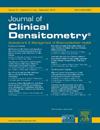Changes in lean mass and fat mass in children with Osteogenesis Imperfecta
IF 1.6
4区 医学
Q4 ENDOCRINOLOGY & METABOLISM
引用次数: 0
Abstract
Background: Deficits in skeletal muscle and function, with resultant abnormal body composition, is a recognised feature of Osteogenesis Imperfecta (OI). Less is known about longitudinal change in body composition in OI. Our objective was to perform a retrospective analysis of longitudinal change in body composition (lean mass and fat mass) in children with OI.
Methodology: Data was collected from 29 children, with a diagnosis of OI, who had at least two dual-energy x-ray absorptiometry (DXA) scans performed between 2015 and 2022. Assessed variables of height, body mass index (BMI), lean mass index (LMI) and fat mass index (FMI), were converted to z scores. Results were reported as median (range).
Results: Median age at baseline and follow-up were 10.7 and 14.2 years, respectively. Median height z-score at baseline was -1.10, which was significantly lower than a control population (p<0.001). Median height z-score at latest follow-up was -0.80, which was not significantly different from baseline (p=0.870). Median BMI z-score at baseline was 0.15, which was not significantly different than a control population (p=0.804). Median BMI z-score at latest follow-up was 0.02, which was not significantly different from baseline (p=0.730). At baseline, median LMI z-score was -2.43, which was significantly lower than a control population (p<0.001). Median LMI z-score at follow-up was -1.78, which was not significantly different from baseline (p=0.080). At baseline, median FMI z-score was 0.57 which was significantly higher than a control population (p=0.001). Median FMI z-score at follow-up was 0.62, which was not significantly different from baseline (p=0.540).
Conclusion: Children with OI have abnormal body composition throughout childhood typically with low lean mass and relatively high fat mass. These abnormalities in body composition do not change with follow-up. Strategies to improve lean mass, including physical or medical therapies, should be explored in OI given the close relationship between muscle and bone.
成骨不全症患儿瘦脂肪量的变化
背景:骨骼肌和功能缺陷,以及由此导致的身体成分异常,是成骨不全症(OI)的一个公认特征。对于成骨不全患者体内成分的纵向变化了解较少。我们的目的是对成骨不全儿童身体组成(瘦质量和脂肪质量)的纵向变化进行回顾性分析。方法:收集29名诊断为成骨不全的儿童的数据,这些儿童在2015年至2022年期间至少进行了两次双能x线吸收仪(DXA)扫描。评估变量身高、身体质量指数(BMI)、瘦质量指数(LMI)和脂肪质量指数(FMI)转换为z分数。结果以中位数(范围)报告。结果:基线和随访时的中位年龄分别为10.7岁和14.2岁。基线时身高z得分中位数为-1.10,显著低于对照人群(p<0.001)。最新随访中位身高z得分为-0.80,与基线无显著差异(p=0.870)。基线时BMI z评分中位数为0.15,与对照组相比差异无统计学意义(p=0.804)。最新随访时BMI z评分中位数为0.02,与基线无显著差异(p=0.730)。基线时,LMI z-score中位数为-2.43,显著低于对照组(p<0.001)。随访时LMI z-score中位数为-1.78,与基线无显著差异(p=0.080)。基线时,FMI z-score中位数为0.57,显著高于对照组(p=0.001)。随访时FMI z-score中位数为0.62,与基线无显著差异(p=0.540)。结论:成骨不全儿童在整个儿童期均存在身体成分异常,典型表现为低瘦体质量和相对高脂体质量。这些身体成分的异常不随随访而改变。考虑到肌肉和骨骼之间的密切关系,在成骨不全症中应该探索改善瘦质量的策略,包括物理或药物治疗。
本文章由计算机程序翻译,如有差异,请以英文原文为准。
求助全文
约1分钟内获得全文
求助全文
来源期刊

Journal of Clinical Densitometry
医学-内分泌学与代谢
CiteScore
4.90
自引率
8.00%
发文量
92
审稿时长
90 days
期刊介绍:
The Journal is committed to serving ISCD''s mission - the education of heterogenous physician specialties and technologists who are involved in the clinical assessment of skeletal health. The focus of JCD is bone mass measurement, including epidemiology of bone mass, how drugs and diseases alter bone mass, new techniques and quality assurance in bone mass imaging technologies, and bone mass health/economics.
Combining high quality research and review articles with sound, practice-oriented advice, JCD meets the diverse diagnostic and management needs of radiologists, endocrinologists, nephrologists, rheumatologists, gynecologists, family physicians, internists, and technologists whose patients require diagnostic clinical densitometry for therapeutic management.
 求助内容:
求助内容: 应助结果提醒方式:
应助结果提醒方式:


